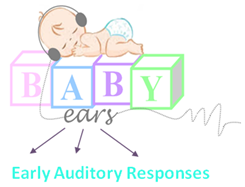Modeling Auditory Responses and Behavioral Outcomes in Preterm Infants

Publications
Prieve, B., Vander Werff, K., Preston J., and Georgantas, L. (2013). Identification of conductive hearing loss in young infants using tympanometry and wideband reflectance. Ear and Hearing, 34, 168-178.
Berg, A., Prieve, B., Serpanos, Y and Wheaton, M. (2011). Hearing screening in a well-baby nursery: Profile of failed auditory brainstem response/passed otoacoustic emissions. Pediatrics. 127(2):269-75.
Vander Werff, K., Prieve, B.A. and Georgantas, L. (2009). Infant air- and bone-conduction toneburst auditory brainstem responses for classification of hearing loss and the relationship to behavioral thresholds. Ear and Hearing, 30, 350-36.
Prieve, B.A., Hancur-Bucco, C., and Preston, J. (2009). Transient-evoked otoacoustic emissions in the first month of life: Frequency changes and debris. Ear and Hearing,30,330-339.
Prieve, B.A., Calandruccio, L., Fitzgerald, T., Georgantas, L. and Mazevski, A. (2008). Changes in transient-evoked otoacoustic emission levels with negative tympanometric peak pressure in infants and toddlers. Ear and Hearing, 29, 533-542.
Smith, J.L., Sterns, A.R., Prieve, B.A. and Woods, C.I. (2008). Anesthetic effects on DPOAE levels, middle ear muscles and the medial olivocochlear reflex in rats. Hearing Research, 235, 47-59.
Vander Werff, K, R., Prieve, B.A. and Georgantas, L. (2007). Test-retest reliability of wideband reflectance measure in infants under screening and diagnostic conditions. Ear and Hearing, 28, 669-681.
Calandruccio, L, Fitzgerald, T., and Prieve, B. (2006). Normative multifrequency tympanometry in infants and toddlers. Journal of the American Acadamy of Audiology, 17, 470-480.
Fitzgerald, T. and Prieve, B. (2005). The clinical utility of distortion product otoacoustic emissions at 2f1-f2 and 2f2-f1. Journal of Speech, Language and Hearing Research, 48, 1165-1186.
Prieve, B. and Stevens, F. (2000). The New York State Universal Newborn Hearing Screening Demonstration Project: Introduction and Overview. Ear and Hearing, 21, 85-91.
Spivak, L., Dalzell, L., Berg, A., Bradley, M., Cacace, A., Campbell, D., DeCristofaro, J., Gravel, J., Greenberg, E., Gross, S., Orlando, M., Pinhiero, J., Regan, J., Stevens, F. and Prieve, B. (2000). The New York State Universal Newborn Hearing Screening Demonstration Project: Inpatient Outcome Measures. Ear and Hearing, 21, 92-103.
Prieve, B., Dalzell, L., Berg, A., Bradley, M., Cacace, A., Campbell, D., DeCristofaro, J., Gravel, J., Greenberg, E., Gross, S., Orlando, M., Pinhiero, J., Regan, J., Spivak, L. and Stevens, F. (2000). The New York State Universal Newborn Hearing Screening Demonstration Project: Outpatient Outcome Measures. Ear and Hearing, 21, 104-117.
Dalzell, L., Berg, A., Bradley, M., Cacace, A., Campbell, D., DeCristofaro, J., Gravel, J., Greenberg, E., Gross, S., Orlando, M., Pinhiero, J., Regan, J., Spivak, L., Stevens, F. and Prieve, B. (2000). The New York State Universal Newborn Hearing Screening Demonstration Project: Ages of hearing loss identification, hearing aid fitting, and enrollment in early intervention.Ear and Hearing, 21, 118-130.
Gravel, J., Berg, A., Bradley, M., Cacace, A., Campbell, D., Dalzell, L., DeCristofaro, J., Gravel, J., Greenberg, E., Gross, S., Orlando, M., Pinhiero, J., Regan, J., Spivak, L., Stevens, F. and Prieve, B. (2000). The New York State Universal Newborn Hearing Screening Demonstration Project: Effects of screening protocol on inpatient outcome measures. Ear and Hearing, 21, 131-140.
Murnane, O. D., Prieve, B.A., and Relkin, E.M. (1998). Recovery of the human compound action potential following prior stimulation. Hearing Research, 124, 182-189.
Fitzgerald, T.S. and Prieve, B.A. (1997). COAE thresholds I: Effects of equal-amplitude vs. subtraction methods. Journal of Speech and Hearing Research, 40, 1164-1176.
Prieve, B.A., Fitzgerald, T.S. and Schulte, L.E. (1997). Basic characteristics of COAEs in infants and children. Journal of the Acoustical Society of America, 102, 2860-2870.
Prieve, B.A., Fitzgerald, T.S., Schulte, L.E. and Kemp, D.T. (1997). Basic characteristics of DPOAEs in infants and children. Journal of the Acoustical Society of America 102, 2871-2879.
Prieve, B.A., Gorga, M.P. and Neely, S.T. (1996). Click-and toneburst-evoked otoacoustic emissions in normal-hearing and hearing-impaired ears. Journal of the Acoustical Society of America, 99, 3077-3086.
Prieve, B.A. and Falter, S.R. (1995). COAEs and SSOAEs in adults with increased age. Ear and Hearing, 16, 521-528.
Prieve, B.A., Gorga, M.P., Schmidt, A.L., Neely, S.T., Peters, J., Schulte, L. & Jesteadt, W. (1993). Analysis of transient-evoked otoacoustic emissions in normal-hearing and hearing-impaired ears. Journal of the Acoustical Society of America, 93, 3308-3319.
Prieve, B.A., Gorga, M.P. & Neely, S.T. (1991). Otoacoustic emissions in an adult with severe hearing loss. Journal of Speech and Hearing Research, 34: 379-385.
Book Chapters
Prieve, B. and Dreisbach, L. (2010). Otoacoustic Emissions. In Richard Seewald and Anne Marie Tharpe (Eds). The Comprehensive Handbook of Pediatric Audiology. Plural Publishing.
Prieve, B. and Fitzgerald, T.(2009). Otoacoustic Emissions. In J. Katz and R. Burkhardt (Ed) Handbook of Clinical Audiology. Sixth Edition. Williams and Wilkins.
Prieve, B. (2007). Otoacoustic Emissions in Neonatal Hearing Screening. In M. Robinette and T. Glattke (Eds). Otoacoustic Emissions: Clinical Applications (3rd Edition). Thieme.
Prieve, B.A. and Fitzgerald, T.S. (2002). Otoacoustic Emissions. In J. Katz and R. Burkhardt (Ed) Handbook of Clinical Audiology. Fifth Edition. Williams and Wilkins.
Prieve, B.A. (2002). Otoacoustic Emissions in Neonatal Hearing Screening. In M. Robinette and T. Glattke (Eds).Otoacoustic Emissions: Clinical Applications (2nd Edition). Thieme.
Orlando, M.S. and Prieve, B.A. (1997). Models for universal newborn hearing screening. In L. Spivak (Ed) Universal Newborn Hearing Screening. New York: Theime.
